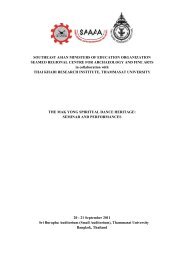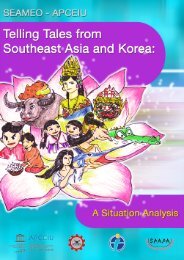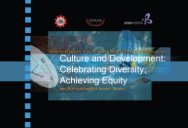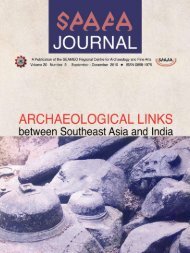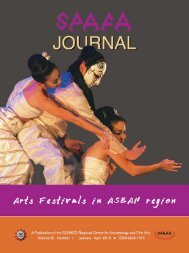on Culture & Development - Seameo-SPAFA
on Culture & Development - Seameo-SPAFA
on Culture & Development - Seameo-SPAFA
- No tags were found...
You also want an ePaper? Increase the reach of your titles
YUMPU automatically turns print PDFs into web optimized ePapers that Google loves.
when/if the different parties arebrought together.It became apparent that as thevarious organisati<strong>on</strong>al groupsdiscussed what words to include intheir lists, how individuals chose torepresent themselves and interpretedtheir own behaviours or practices, andhow they felt that others saw themvaried c<strong>on</strong>siderably. This was apparentnot <strong>on</strong>ly am<strong>on</strong>g those from what wereassumed to be similar types oforganisati<strong>on</strong>, but also betweenindividuals from different centres,offices or departments of the sameorganisati<strong>on</strong>. Whilst each group wasable to agree <strong>on</strong> lists of negative andpositive organisati<strong>on</strong>al characteristicsin the broader sense, the importantless<strong>on</strong> learned was that in terms ofour work partnerships, the importantfactor is not so much whichorganisati<strong>on</strong>s we are involved with,but who is involved at the individuallevel. It is the relati<strong>on</strong>ship thatdevelops between individuals and theeffectiveness of the communicati<strong>on</strong>that takes place between them thatcreates space for innovati<strong>on</strong> andcreativity, allowing the partners to findnew soluti<strong>on</strong>s and build new bridgesthat can lead to successful andsustainable development.In the development world, thefrequent use of the word“empowerment” has manyinterpretati<strong>on</strong>s. More often than not itimplies the giving of power from asupposedly ‘superior’ group to a‘subordinate’ group through, forexample, the transfer of technicalskills or knowledge. At times itincorporates a noti<strong>on</strong> of <strong>on</strong>e grouprelinquishing power so that anothergroup can take the lead or ‘be in thedriving seat’; but rarely does it givemuch attenti<strong>on</strong> to the way powershifts c<strong>on</strong>stantly between these twoextremes. Activity 4.4 allowsparticipants to develop role playsaround everyday relati<strong>on</strong>ships toillustrate and draw attenti<strong>on</strong> to theseshifts, taking into account thenumerous coping strategies all of usdevelop to simply get by, get <strong>on</strong> or getwhat we want. If transferred to thework c<strong>on</strong>text, heightened awarenessof these shifts may help us to betterunderstand what is actually happeningbetween the various stakeholders of aproject or programme; to know who isspeaking for whom; to know whenyes actually means yes; or to be moreaware of ulterior motives and privateagendas.99



